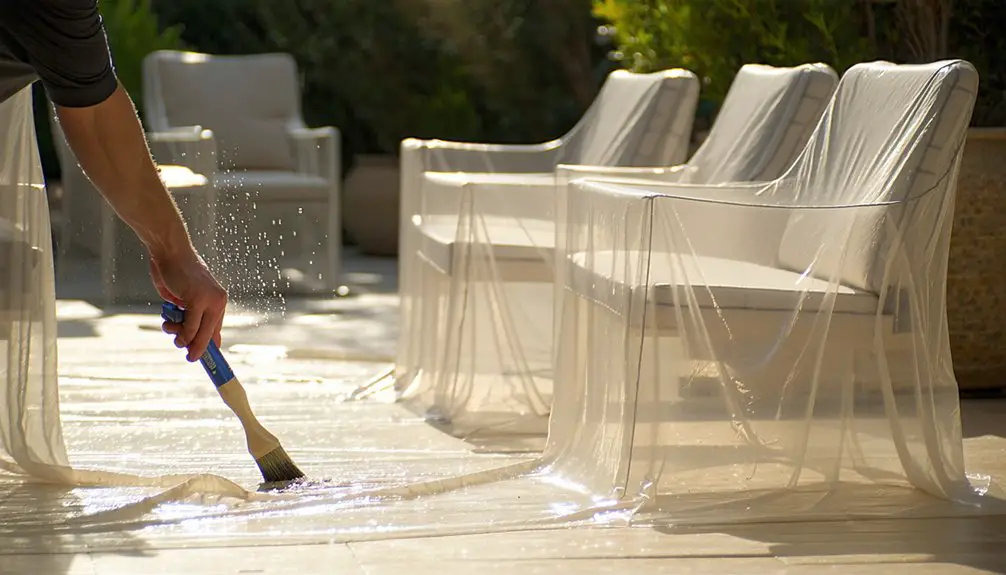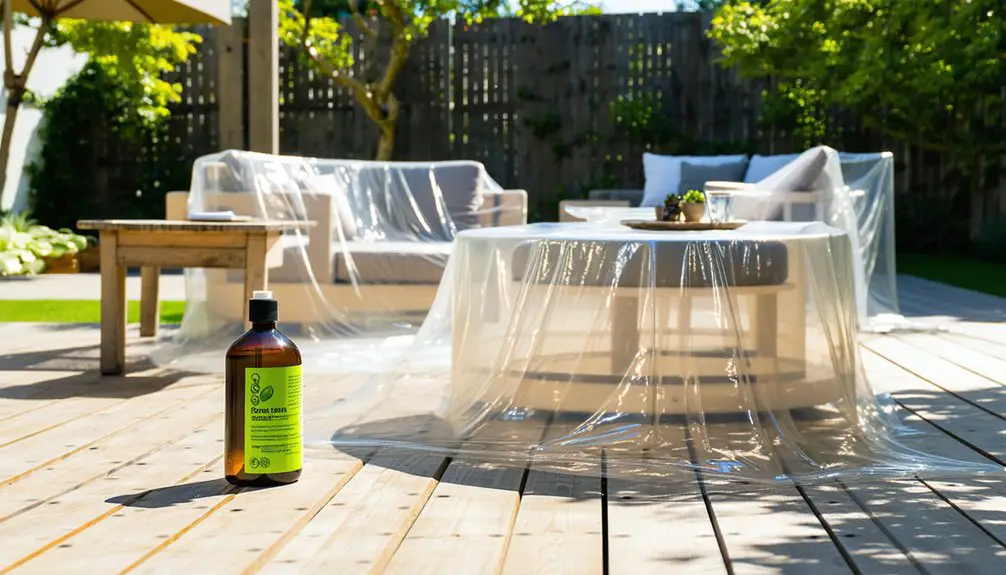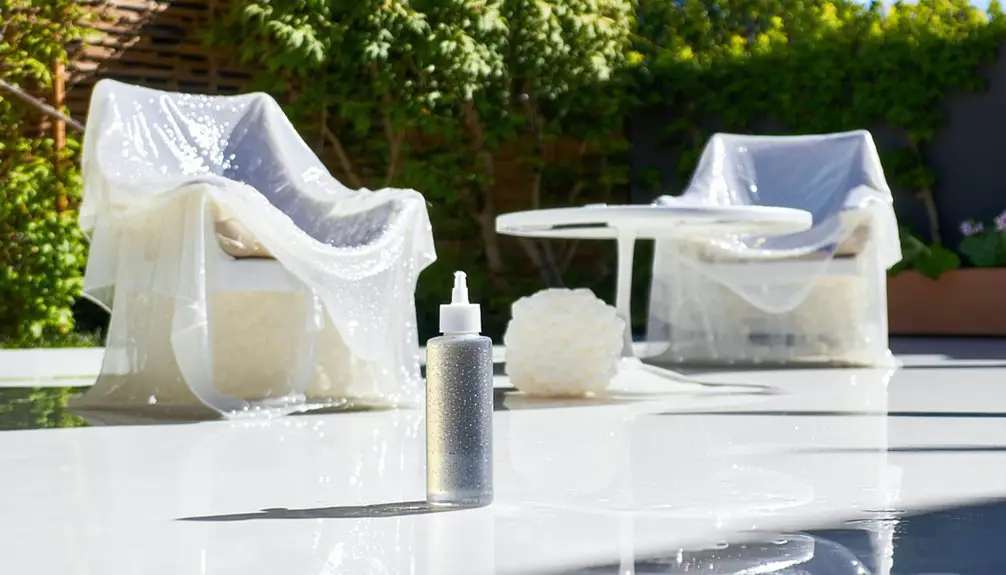Protecting your plastic furniture with covers and sealants is key to keeping it looking great and lasting longer. Choose from durable options like polyethylene, vinyl, or polyester, each providing excellent weather resistance and stain protection. Secure your covers with drawstrings or clamps for a snug fit. Regular maintenance, like cleaning with mild soap and storing them properly, can extend their life significantly. Consider applying a sealant for added moisture protection and to enhance durability. With the right care and products, your furniture can resist dirt and weather damage, ensuring it stays in top condition. There's plenty more helpful info to explore!
Key Takeaways
- Use durable polyethylene or vinyl covers to shield plastic furniture from dirt, dust, and moisture, extending its lifespan.
- Apply sealants designed for plastic surfaces to enhance water resistance and protect against UV damage.
- Regularly clean covers with mild soap and warm water to maintain their protective qualities and prevent deterioration.
- Secure covers with drawstrings or straps to ensure a snug fit and prevent them from blowing away in windy conditions.
- Store covers in waterproof containers when not in use to keep them clean and ready for future protection.
Types of Covers Available
When it comes to protecting your plastic furniture, you'll find a variety of cover types available to suit your needs. One popular option is polyethylene, made from durable low-density polyethylene. You can choose from different thicknesses—1 mil, 2 mil, and 3 mil—depending on how much protection you need against dirt, dust, and moisture. These covers are often perforated on rolls, making them easy to dispense for storage or moving. Additionally, durable plastic furniture covers are ideal for various sizes of chairs, loveseats, and sofas. Regular cleaning with mild soap and warm water helps prevent dirt buildup and extend the lifespan of these covers.
Another excellent choice is polyester, known for its durability and water-resistant properties. It's particularly effective for outdoor furniture, often available in 600D polyester canvas for added toughness. This material ensures long-lasting coverage, regardless of the weather conditions, and UV protectors can further enhance its durability.
Vinyl covers also offer heavy-duty protection against the elements. They're resistant to mold and mildew, making them ideal for outdoor use in various climates. Many vinyl options come with multi-year warranties, giving you peace of mind.
Lastly, canvas polyester combines the benefits of both canvas and polyester, providing robust protection. These specialized covers can be customized to fit your specific furniture sizes, ensuring a snug and secure fit.
Benefits of Using Covers
Using protective covers for your plastic furniture offers a multitude of benefits that can enhance its longevity and appearance. First and foremost, these covers shield your furniture from dirt, dust, and moisture, preventing stains and keeping it looking new for longer.
They also guard against scratches, tears, and fading from sunlight exposure, ensuring your furniture remains in excellent condition. Additionally, these covers help maintain furniture appearance, prolonging lifespan and protecting against fading due to sunlight exposure.
Durability is another key advantage. Made from robust low-density polyethylene, high-quality covers can last between 5 to 10 years with proper care, often exceeding the lifespan of traditional upholstery.
These materials can withstand harsh weather, making them perfect for outdoor use.
Ease of use is a significant benefit too. You'll find that protective covers are simple to install and remove, and they come perforated on rolls for quick dispensing.
Their lightweight design makes moving furniture a breeze, and cleaning is a quick task—just wipe them down to prevent dirt buildup.
Lastly, protective covers are cost-effective. They're more affordable than traditional upholstery and provide long-term investment by safeguarding your furniture against various damages while adding a pleasing aesthetic touch.
Application and Installation Methods

Applying and installing protective covers for your plastic furniture is straightforward and efficient. Start by covering the furniture piece with the protective cover. Once in place, secure it by tying the drawstrings or straps, or by connecting the Velcro pieces tightly. To further ensure stability, use cover clamps; place them at the bottom and opposite sides of the cover, with the teeth on either side of the hem. Slide the crossbar towards the teeth to lock the clamp. Additionally, using covers can significantly enhance the longevity of your furniture by protecting it from environmental damage.
For added security, bungee cords work wonders. Position a bungee cord behind the leg or wheel of the furniture, and attach the hook through the front clamp inserts. Then connect a second bungee cord's hook to the rear inserts for a snug fit.
Here's a quick overview of the application process:
| Step | Description |
|---|---|
| 1. Cover | Drape the protective cover over the furniture. |
| 2. Secure | Tie drawstrings or connect Velcro pieces. |
| 3. Clamp and Bungee | Use clamps and bungee cords for extra security. |
With these steps, you'll be well on your way to protecting your plastic furniture effectively!
Maintenance Tips for Covers
Maintaining your protective covers is essential for prolonging their lifespan and ensuring your plastic furniture remains well-protected. Start by shaking off any debris before rinsing the cover thoroughly with a garden hose. Clean it using mild soap and warm water, applying a sponge or bristle brush. Avoid machine washing or drying, as this can damage the fabric. To protect your covers further, consider using Golden Care Fabric Cleaner to prevent stains. Twice a year, apply Golden Care Fabric Nanoprotector to maintain their water and dirt repellency. Additionally, applying a fabric nanoprotector helps create an invisible barrier that promotes water and dirt repellency.
Regularly inspect your covers for wear and tear, and treat them to restore water repellency after cleaning. To secure your covers, use Cover Clamps to prevent them from shifting or blowing away. When storing, fold covers neatly on a flat surface and keep them in a waterproof container or a Cover Storage Bag. For easy identification, label each cover with a tag. To prevent water pooling, utilize inflatable air bags that match your furniture's shape, ensuring they fill the low points of the cover. Regularly check for signs of mold or moisture damage to keep your covers in top condition.
Environmental Considerations and Practices

When it comes to protecting your plastic furniture, considering environmental practices is key to making a positive impact. By opting for recycled plastic, you're not just extending the lifespan of your furniture but also significantly reducing plastic waste. This choice helps divert waste from landfills and oceans, cutting down on pollution and habitat destruction. Additionally, using sustainable building materials in outdoor furniture contributes to a more eco-friendly environment.
Here's a quick look at the benefits of sustainable practices:
| Aspect | Benefits | Impact |
|---|---|---|
| Recycling | Extends material lifespan | Reduces landfill waste |
| Energy Consumption | Less energy used in production | Lowers carbon footprint |
| Sustainable Materials | Alternatives like cork and bamboo | Prevents deforestation |
| Circular Economy | Encourages reuse and recycling | Saves resources |
| Indoor Air Quality | Uses low VOC finishes | Enhances living environment
Frequently Asked Questions
How Do I Choose the Right Cover Size for My Furniture?
To choose the right cover size for your furniture, measure each piece carefully, accounting for shape and protrusions. Opt for a cover slightly larger for proper fit, ensuring it secures well against wind and weather.
Can I Use Covers Indoors, or Are They Only for Outdoor Use?
You can definitely use covers indoors! They protect your furniture from dust, stains, and everyday wear while allowing easy identification. Plus, they're available in various sizes to fit your indoor furniture perfectly.
Are There Any Specific Brands Recommended for Plastic Furniture Covers?
When choosing covers, consider brands like Storage Standard, known for durable, water-resistant options. Polypropylene and HDPE materials are excellent for weather resistance, while vinyl and polyester offer mold protection and longevity for your furniture.
How Long Can I Expect Covers to Last Before Needing Replacement?
You can expect covers to last anywhere from 1 to 10 years, depending on factors like material quality, weather conditions, and maintenance. Regular inspections and proper care can significantly extend their lifespan.
Do Covers Affect the Appearance of My Furniture Over Time?
Covers can impact your furniture's appearance over time. They might trap moisture, leading to mold or discoloration. Regularly check underneath and clean the covers to minimize any potential damage and maintain your furniture's aesthetics.

